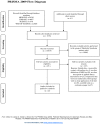Dietary Interventions and Changes in Cardio-Metabolic Parameters in Metabolically Healthy Obese Subjects: A Systematic Review with Meta-Analysis
- PMID: 27483307
- PMCID: PMC4997370
- DOI: 10.3390/nu8080455
Dietary Interventions and Changes in Cardio-Metabolic Parameters in Metabolically Healthy Obese Subjects: A Systematic Review with Meta-Analysis
Abstract
The aim of this systematic review was to assess the effect of diet on changes in parameters describing the body size phenotype of metabolically healthy obese subjects. The databases Medline, Scopus, Web of Knowledge and Embase were searched for clinical studies carried out between 1958 and June 2016 that reported the effect of dietary intervention on BMI, blood pressure, concentration of fasting triglyceride (TG), high density lipoprotein cholesterol (HDL-C), fasting glucose level, the homoeostatic model assessment of insulin resistance (HOMA-IR) and high sensitivity C-Reactive Protein (hsCRP) in metabolically healthy, obese subjects. Twelve clinical studies met inclusion criteria. The combined analyzed population consists of 1827 subjects aged 34.4 to 61.1 with a BMI > 30 kg/m². Time of intervention ranged from eight to 104 weeks. The baseline characteristics related to lipid profile were more favorable for metabolically healthy obese than for metabolically unhealthy obese. The meta-analyses revealed a significant associations between restricted energy diet and BMI (95% confidence interval (CI): -0.88, -0.19), blood pressure (systolic blood pressure (SBP): -4.73 mmHg; 95% CI: -7.12, -2.33; and diastolic blood pressure (DBP): -2.75 mmHg; 95% CI: -4.30, -1.21) and TG (-0.11 mmol/l; 95% CI: -0.16, -0.06). Changes in fasting glucose, HOMA-IR and hsCRP did not show significant changes. Sufficient evidence was not found to support the use of specific diets in metabolically healthy obese subjects. This analysis suggests that the effect of caloric restriction exerts its effects through a reduction in BMI, blood pressure and triglycerides in metabolically healthy obese (MHO) patients.
Keywords: biomarkers; diet; metabolically healthy obese.
Figures







References
-
- Wildman R.P., Muntner P., Reynolds K., McGinn A.P., Rajpathak S., Wylie-Rosett J., Sowers M.R. The obese without cardiometabolic risk factor clustering and the normal weight with cardiometabolic risk factor clustering: Prevalence and correlates of 2 phenotypes among the US population (NHANES 1999–2004) Arch. Intern. Med. 2008;168:1617–1624. doi: 10.1001/archinte.168.15.1617. - DOI - PubMed
Publication types
MeSH terms
Substances
LinkOut - more resources
Full Text Sources
Other Literature Sources
Medical
Research Materials
Miscellaneous

